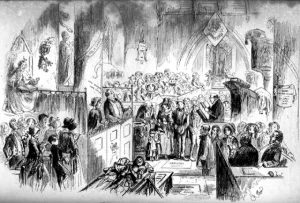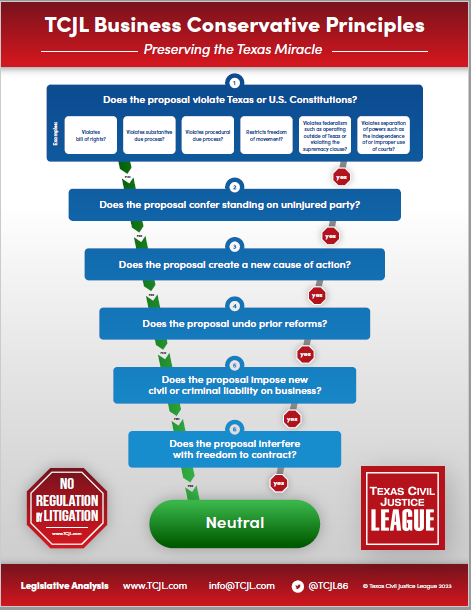 In a case that increasingly resembles Jarndyce v. Jarndyce, the Texas Supreme Court has remanded a two-decades-old legal malpractice case for a third go around in the trial court.
In a case that increasingly resembles Jarndyce v. Jarndyce, the Texas Supreme Court has remanded a two-decades-old legal malpractice case for a third go around in the trial court.
Henry S. Miller Commercial Company v. Newsom, Terry & Newsom, LLP and Steven K. Terry (No. 22-1143; December 31, 2025) arose from a fraud case brought by Nussbaum, who bought, renovated, and sold apartment complexes and office buildings, against Henry S. Miller (HSM) and Defterios, an independent contractor of HSM whom HSM allowed to style himself a “vice president.” Nussbaum’s claimed that HSM and Defterios misrepresented that an investor, Flaven (who turned out to be a truck driver from Massachusetts), wanted to spend $100 million on Texas properties. When Nussbaum set up the deals on various properties, Defeterios repeatedly delayed closing, eventually causing the deals to collapse in 2005. Nussbaum sued, claiming that his properties lost value during the delays and ultimate failure of the deals. Nussbaum did not sue Flaven, preferring to load all of the liability on HSM. HSM’s lawyer, Terry, knew that joining Flaven could reduce HSM’s proportionate liability but held off joining Flaven until a few days before trial. Nussbaum objected to the joinder, which the trial court denied. The jury ultimately found HSM and Defeterios liable for fraud and negligent misrepresentation, and, in December 2008, the trial court awarded Nussbaum $8.1 million plus pre- and postjudgment interest. HSM and Defterios appealed only the damages, which the court of appeals affirmed (HSM I).
In early 2009, HSM sued its insurer, Diamond, for denying coverage on its errors and omissions policy and Terry for legal malpractice. Several months later Nussbaum filed an involuntary bankruptcy petition against HSM as a judgment creditor. In July 2010, Nussbaum and HSM agreed on a reorganization plan under which HSM giving HSM sole control over its litigation against Diamond and Terry in return for Nussbaum receiving the first $5 million of any judgment or settlement (HSM also agreed not to settle for less than $5 million). Nussbaum also agreed to help HSM in maximizing the recovery, including consenting to a temporary injunction prohibiting enforcement of his judgment against HSM pending HSM’s efforts to recover from Diamond and Terry. HSM and Diamond eventually settled for $6 million. HSM’s suit against Terry was tried in April 2014. Although opponents in the fraud case, Nussbaum and HSM aligned against Terry in the malpractice case. The court directed a verdict for Terry on HSM’s gross negligence claims, but the jury found that Terry was negligent in not joining Flaven and that had he done so, Nussbaum’s recovery in the fraud case would have been reduced by $4.6 million. Applying the $6 million settlement credit to the verdict left HSM with no recovery in the malpractice suit.
Both sides appealed. The Court of appeals held that Nussbaum and HSM’s settlement of the bankruptcy was not an illegal assignment of HSM’s malpractice claim, even though it involved Nussbaum switching sides from his opposition to HSM in the fraud case. The court reversed the trial court’s directed verdict on the gross negligence claim and remanded for new trial. The second trial, which occurred in November 2019, resulted in a jury determination that Terry was grossly negligent and negligent in failing to timely join Flaven as an RPT when he knew it would likely reduce Nussbaum’s recovery against HSM. The jury awarded $6 million in punitive damages, $1 million against Terry’s firm, and $13.6 in actual damages. Terry appealed. The court of appeals reversed again, this time on the basis that the trial court gave an improper jury instruction that it viewed as commenting on the weight of the evidence to Terry’s detriment. Both sides appealed, and SCOTX granted review.
In an opinion by Chief Justice Hecht (we suppose his last!), SCOTX remanded for a third trial, but on different grounds than the court of appeals. First, the Court agreed with the court of appeals that HSM’s settlement with Nussbaum in the bankruptcy reorganization did not constitute an illegal assignment of HSM’s legal malpractice claim to Nussbaum. Although Texas law prohibits the assignment of a legal malpractice claim arising from litigation, the Chief Justice wrote, “someone with less than ownership of a claim may still exert control over its prosecution and have an interest in recovery.” And this is true even if that involves “a pernicious distortion of positions,” such as the realignment of Nussbaum in this case. The question is whether “the client (HSM here) retains substantial control, [] even though the distortion cannot be completely cured by disclosure or other procedures.” It’s the trial court’s task to make sure that those interests are fully disclosed.
The Court then turned to the legal sufficiency questions around the negligence and gross negligence findings in the second trial. Finding that the evidence supported the conclusion that Terry was negligent in not designating Flaven as an RPT, the Court stated that the jury could apportion some of the fault to Terry instead of 100% to HSM. Observing that Nussbaum’s counsel stated as such, the Court implicitly chastised him for his “blatant flip in positions in the malpractice case for transparently financial reasons” after arguing “insistently” in the fraud case that HSM was 100% responsible for his client’s damages. But the Court found only conclusory evidence that supported the jury’s finding that Terry was 100% responsible for HSM’s judgment in the fraud case. In other words, it was pure speculation as to what the jury would have done in the fraud case had Flaven’s fault been put to it. HSM’s “expert” opinion was just another lawyer with a guess as good as any other. As the Chief Justice put it, “[e]ven an experienced lawyer ‘cannot simply say, “Take my word for it ….”’” In the absence of evidence that Terry was the sole cause of HSM’s defeat in the fraud case, even if Terry was indeed negligent, the jury’s award of the total amount of HSM’s damages must fall. As to the gross negligence finding, the Court found no evidence that Terry was “consciously indifferent” to HSM’s interests in the fraud case. While he delayed joining Flaven until it was too late, Terry knew about and weighed the strategic issues involved all the way up to the first trial. Put another way, the exercise of his professional judgment about the best course of action, while ultimately negligent, did not rise to the level of gross negligence. The trial court was thus correct when it directed a verdict for Terry on the gross negligence issue in the first trial.
So the case goes back to the trial court for a third trial on the HSM’s legal malpractice claim against Terry. Supposing it goes all the way through the process once more, the case could end up stretching out over a quarter century. If only Dickens were alive to see this. The only thing needed to complete the picture is a case of spontaneous combustion.











